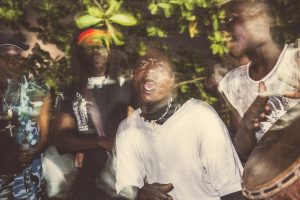
Black Music Month – Afrobeats: Defining the Pulse
As June honors the people, places, and cultural influences of Black Music Month, it would be impossible not to mention the impact that Afrobeats has had not just on hip-hop music, but pretty much all major genres of music.
Afrobeats, not to be confused with the 1970s Afrobeat pioneered by Fela Kuti, is a contemporary West African music genre that fuses a wide array of traditional and global influences. At its core, Afrobeats draws heavily from highlife, juju, and Afro-juju, genres rooted in Nigeria and Ghana. Highlife contributes intricate guitar riffs and melodic horn sections, while juju brings Yoruba talking drums and rhythmic percussion. Afro-juju, a hybrid of juju and pop, laid the groundwork for Afrobeats’ fusion of traditional rhythms with modern sounds. Fela Kuti’s 1975 song “Water No Get Enemy” is a good example for understanding the genre’s rhythmic foundation and social consciousness. The hypnotic groove, jazz-inflected horns, and layered percussion set a blueprint for future generations while Wizkid’s “Ojuelegba” (2014) blends Yoruba storytelling, soulful melodies, and a subtle highlife influence. It captures the genre’s emotional depth and urban narrative style.
The genre’s infectious energy stems largely from its polyrhythmic complexity. Syncopated drum patterns, often built around the “dem bow” rhythm, form the backbone, supplemented by percussive layers from congas, talking drums, and digital drum machines. Rhythms like the 3-2 clave and swing-inflected hi-hats keep the beat fluid yet driving, making Afrobeats irresistibly danceable and also easily blendable into a variety of dance-based genres. For example, Burna Boy fuses Afrobeat rhythms with dancehall bounce and hip-hop confidence in his 2018 hit “Ye.” The track’s call-and-response vocals, heavy bass, and socially aware lyrics showcase the genre’s international swagger. At the same time, Rema’s 2022 pop crossover hit, “Calm Down,” employs a bouncy, mid-tempo rhythm with layered percussion and a catchy hook. Rema’s vocal phrasing reflects Afro-juju stylings while integrating pop structure and melodic clarity.
Instrumentation in Afrobeats blends traditional and electronic tools. While highlife-inspired guitars and horns remain central, producers now incorporate synths, Auto-Tune, and sampled beats, creating a glossy, global sound. Vocal styles range from melodic crooning to rapid-fire patois-inflected delivery, reflecting the influence of R&B, hip-hop, and dancehall. Artists like Wizkid, Burna Boy, and Tems seamlessly transition between Yoruba, Pidgin English, and standard English, lending the music a multilingual, pan-African appeal.
Contemporary Afrobeats also bears the imprint of hip-hop’s swagger, R&B’s smoothness, and dancehall’s rhythmic drive. The result is a genre that is both deeply rooted and wildly innovative, a sonic tapestry that captures the spirit of modern Africa while resonating with audiences worldwide. It’s this blend of tradition and modernity, rhythm and melody, that gives Afrobeats its undeniable global magnetism.